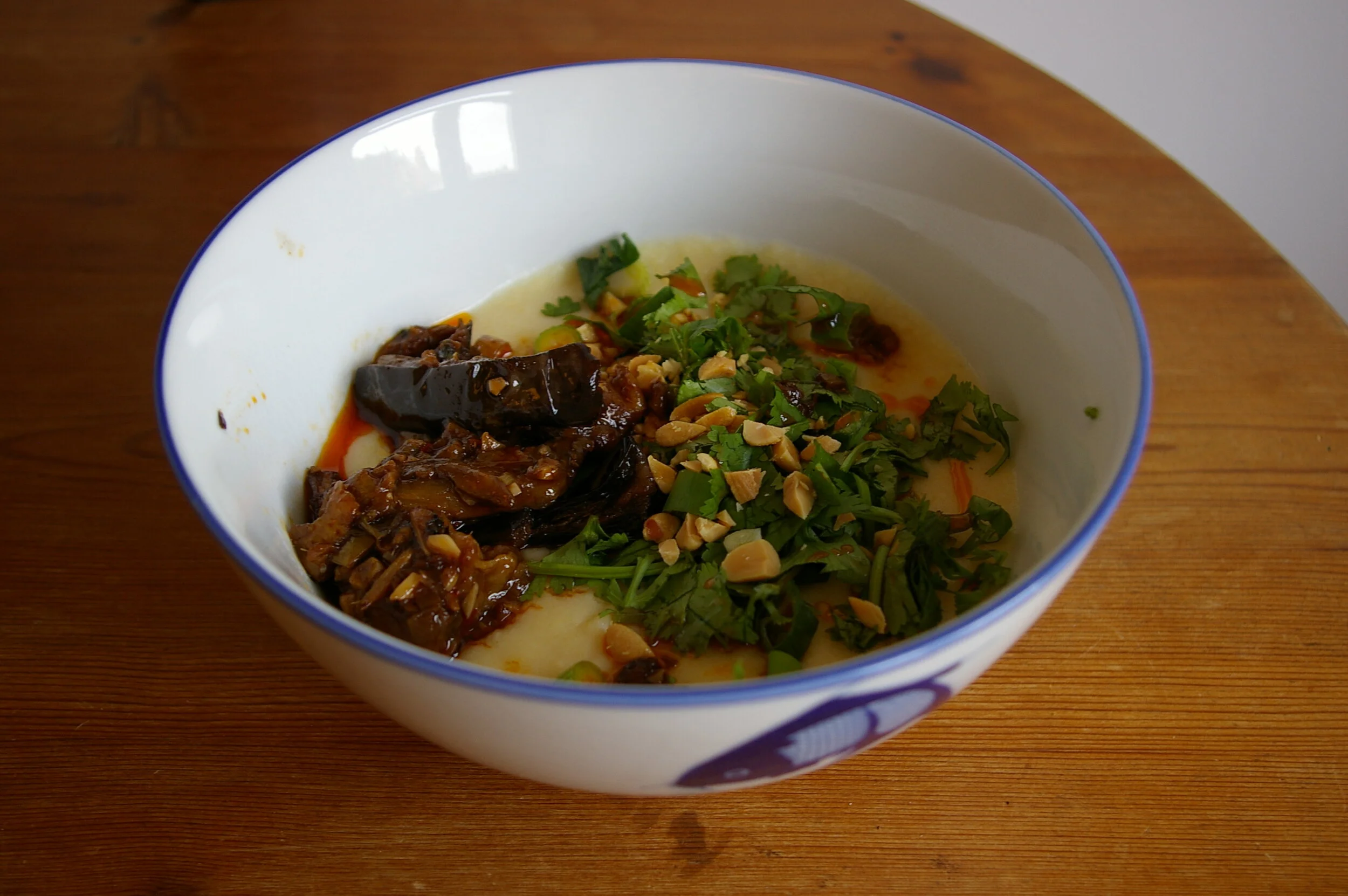What is Wāndòufěn and what should we call it in English?
Spoiler: it’s a delicious naturally vegan pea-based street food snack from Yunnan and I have no idea what to call it. Scroll down for recipe.
Perhaps like me, you’re uneasy with food names derived from the equation ‘Chinese + western equivalent’ i.e. where Gua Bao (割包) and Ròu jiā mó (肉夹馍) become ‘Chinese burgers’, Bābā (粑粑) bread becomes ‘Chinese pizza’ and Jiānbing (煎饼) become ‘Chinese crêpes’. This kind of translation may help popularise a dish by offering a reference point to Western consumers but can end up oversimplifying and demeaning the original.
But what should we do when a literal translation does not do justice to the dish?
Dehong Dai Flavour, Kunming 2014 (Xīdòufěn in the bowl top right)
If you haven’t come across Wāndòufěn before, some of the literal translations available online might put you right off. Pea gruel anyone? Hardened pea porridge, pea jelly or dilute pea flour meal? No…I didn’t think so.
So whilst Wāndòufěn is an amazing dish in its own right, here are some of the edible reference points my untrained Western palate jumped to on first bite in Kunming back in 2014 - Wāndòufěn has the creamy richness of a good hummus and the soft comforting mushiness of polenta. The chilli-infused oil and toppings are a bit like the tempered spices and oil of dal tadka. As I’ve learned more about the dish, more comparisons have formed: Wāndòufěn is made using the same procedure as Burmese shan tofu (but with yellow split peas instead of chickpeas) but it can also be made directly from pea flour with the ‘just add water’ ease of Smash. And like many/all of the best foods around the world - it’s all about the customised toppings!
Strictly speaking we’re really talking about two different dishes here using exactly the same ingredients but with a slightly different cooking procedure. Wāndòufěn, sometimes also called Xīdòufěn (稀豆粉)is a widely available street food snack commonly eaten for Breakfast in Kunming, Yunnan which is where I first tried it in 2014. It’s available as a starchy warm pea porridge or cooled, hardened and cut into ‘jelly noodles’ as Wāndòu liángfěn (豌豆凉粉). I’ve yet to come across it in London but have been trying to recreate it and work out what to call it in English ever since.
Whilst I’m still stuck for an appealing English language name, here’s my attempt at a recipe below using yellow pea-flour (I used Hodmedod’s which was easy to buy online). My first attempt at a recipe used dried yellow split peas which were soaked overnight and then blended before cooking but having now tried both, I think the pea flour creates a much smoother, creamier result.
Please share your ideas and suggestions as I’d love to learn more about Wāndòufěn and other Chinese plant-based dishes! How should we translate Wāndòufěn? Where can I eat this in London? Do you have any more ideas for toppings? Would this work with other legumes? Do you think street vendors add stock to their Wāndòufěn?
Wāndòu liángfěn (豌豆凉粉)
This photo was taken from my first batch using the dried yellow-split peas. With an average blender like mine, the texture was a little on the grainy side.
Wāndòufěn (豌豆粉) with some cheeky fish-fragrant aubergine leftovers!
Beware overcooking - the mixture will harden too quickly!
Toppings: pickles, chopped walnuts and sweetened dried radish
Recipe for Wāndòufěn
Serves: 2
Time: 20 mins
Ingredients:
· 100g yellow pea flour (I used Hodmedod’s)
· 700ml water
· 1 teaspoon Salt
Toppings:
Choose your own from the suggestions below.
chilli oil
minced ginger
minced garlic
roasted crushed peanuts
pickled radish
chopped coriander
soy sauce
toasted sesame oil
Chinkiang vinegar
finely chopped spring onions
chopped walnuts
Optional extras: yóutiáo(油条), jiānbing (煎饼) or shāobǐng(烧饼)for scooping/dipping
Method:
1. Place the pea flour in a saucepan over a low heat and add a few tablespoons of the water. Stir well to ensure there are no lumps. This part feels similar to making a roux.
2. Add the rest of water and salt and continue gently stirring over a medium heat until you start to feel resistance against the spoon (after 10 minutes or so). Keep stirring until the mixture has thickened but be careful not overcook as you want to end up with a gloopy mixture rather than a hardened cake (which I ended up with in my first attempt!).
3. Prepare your toppings of choice. These can either be tempered with boiling hot oil to release extra flavour, or kept cold and raw to provide more of a contrast to the warm starchy pea porridge.
4. To eat warm, simply serve the Wāndòufěn in bowls with your chosen toppings poured over the top. You could just eat this with a spoon, or you could go the extra mile and serve it with fried dough sticks, jiānbing or shāobǐng acting as edible scoops!
5. To eat cold as Wāndòu liángfěn or ‘pea jelly noodles’, allow the mixture to cool in a covered bowl or box, refrigerate until hardened and then cut into thick rectangular ‘noodles’. Pile onto a plate or into a bowl and add your chosen toppings.






